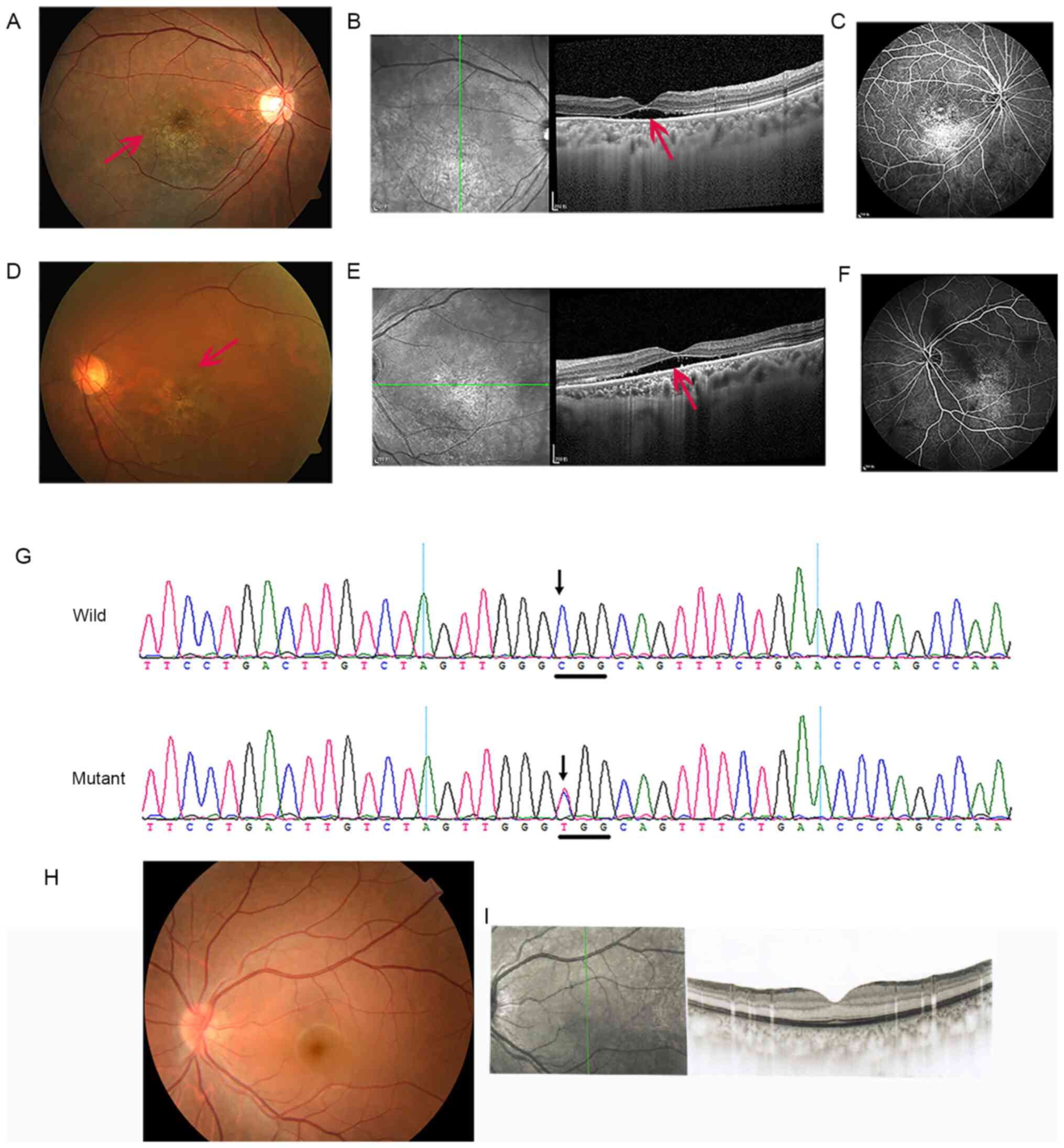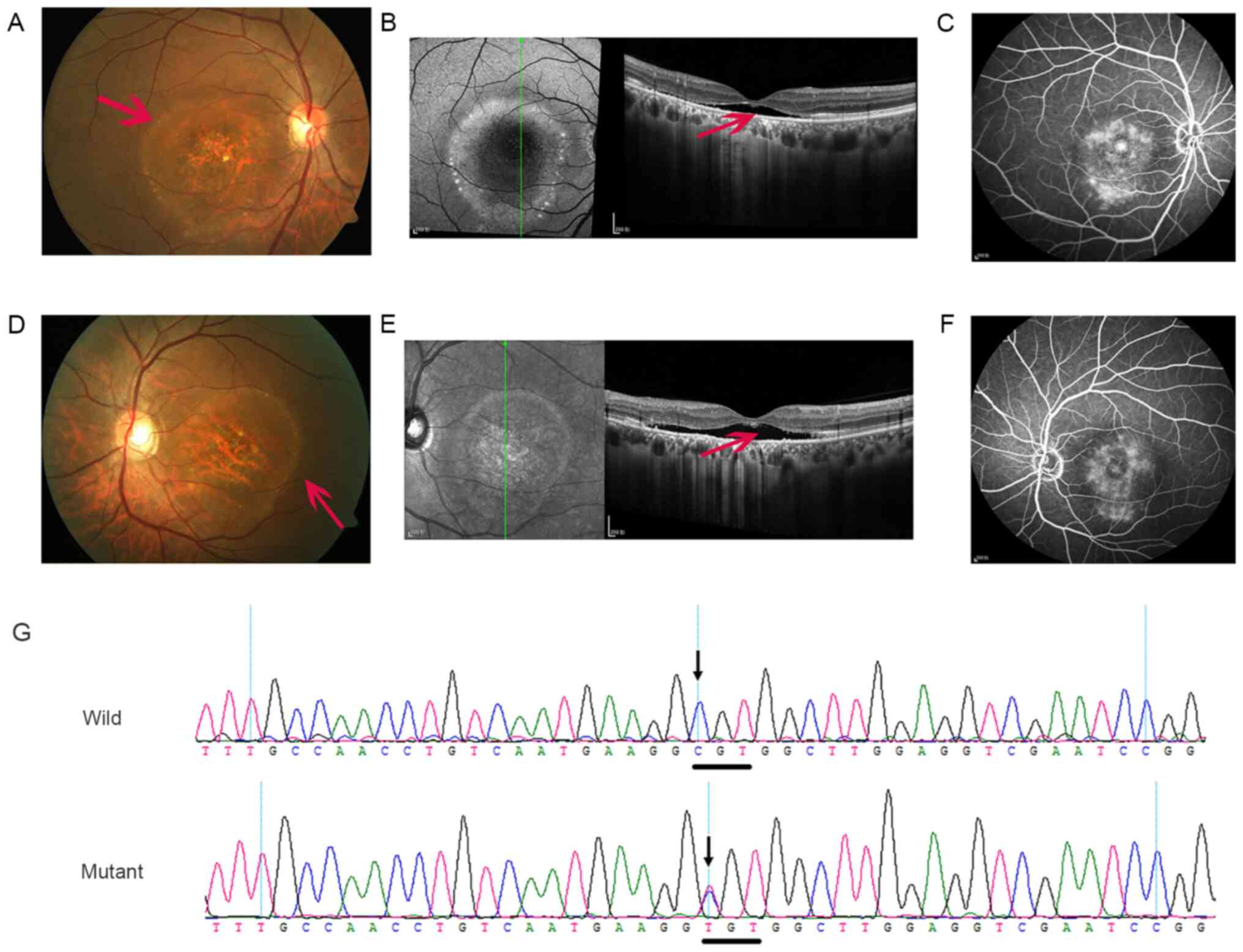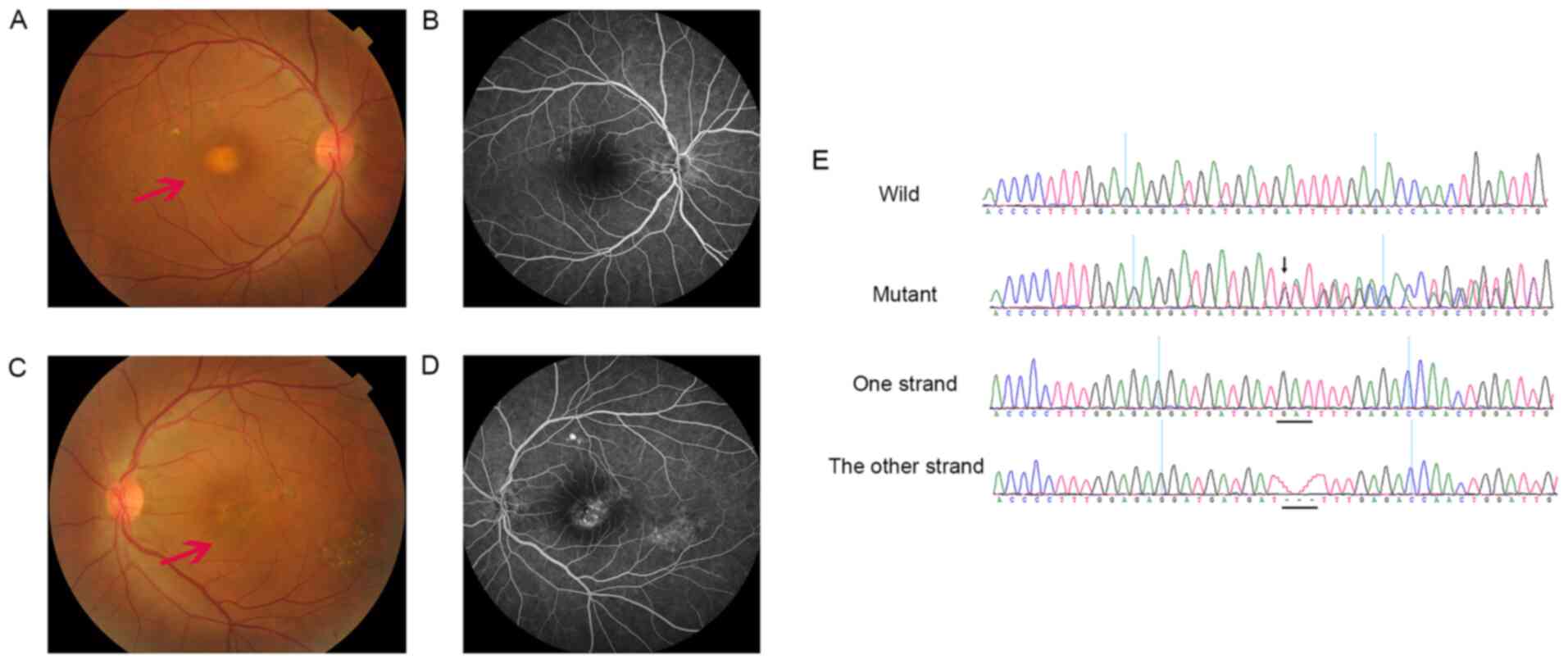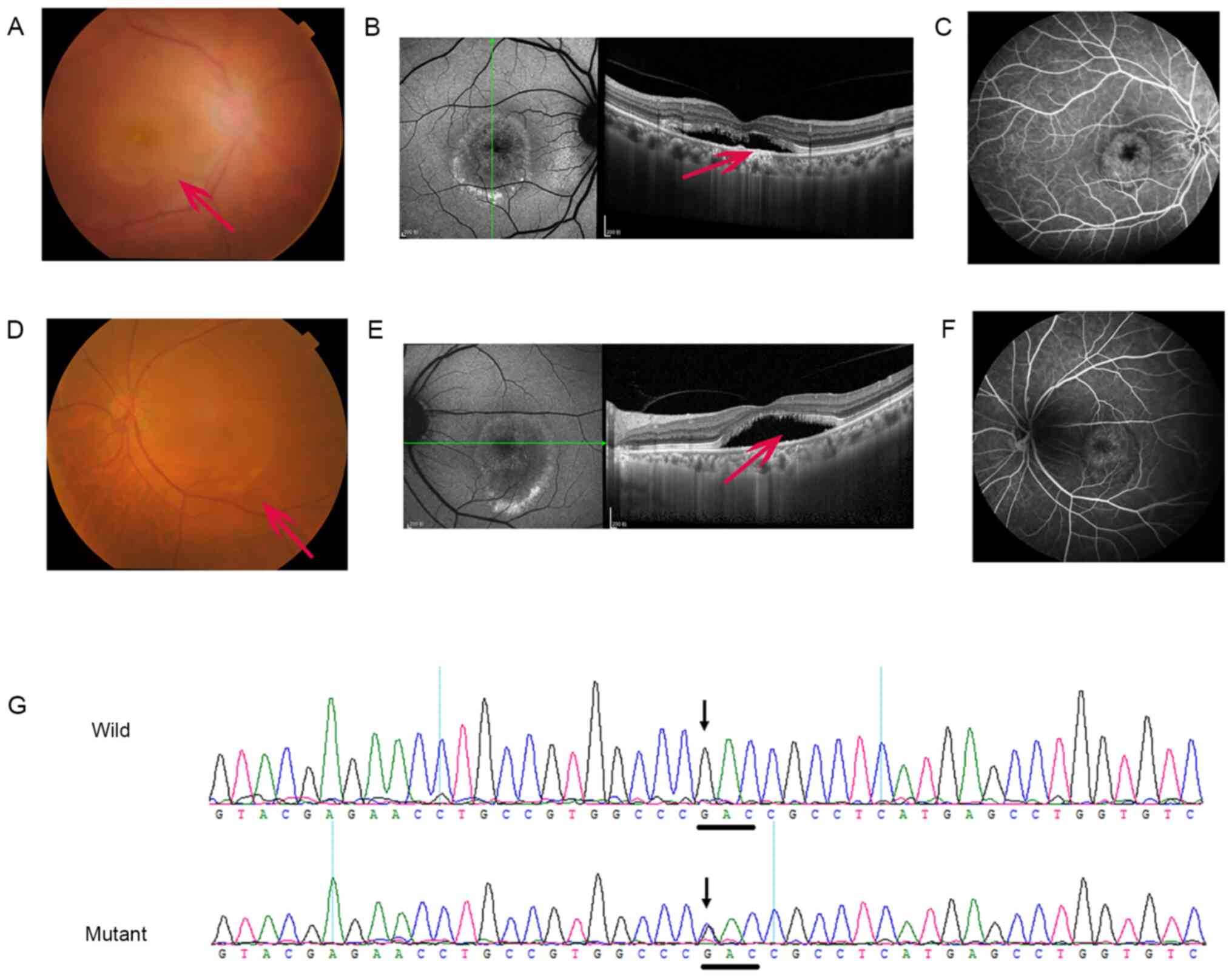|
1
|
MacDonald IM and Lee T: Best vitelliform
macular dystrophy. In: GeneReviews((R)). Adam MP, Ardinger HH and
Pagon RA (eds). University of Washington, Seattle, WA, 1993.
|
|
2
|
Katz MS, Walsh EK and Medow NB:
Vitelliform macular dystrophy. JAMA Ophthalmol.
132(1098)2014.PubMed/NCBI View Article : Google Scholar
|
|
3
|
Tsang SH and Sharma T: Best vitelliform
macular dystrophy. Adv Exp Med Biol. 1085:157–158. 2018.PubMed/NCBI View Article : Google Scholar
|
|
4
|
Gass JD: A clinicopathologic study of a
peculiar foveomacular dystrophy. Trans Am Ophthalmol Soc.
72:139–156. 1974.PubMed/NCBI
|
|
5
|
Chowers I, Tiosano L, Audo I, Grunin M and
Boon CJ: Adult-onset foveomacular vitelliform dystrophy: A fresh
perspective. Prog Retin Eye Res. 47:64–85. 2015.PubMed/NCBI View Article : Google Scholar
|
|
6
|
Jun I, Lee JS, Lee JH, Lee CS, Choi SI,
Gee HY, Lee MG and Kim EK: Adult-onset vitelliform macular
dystrophy caused by BEST1 p.Ile38Ser mutation is a mild form of
best vitelliform macular dystrophy. Sci Rep. 7(9146)2017.PubMed/NCBI View Article : Google Scholar
|
|
7
|
Toto L, Borrelli E, Mastropasqua R, Di
Antonio L, Mattei PA, Carpineto P and Mastropasqua L: Adult-onset
foveomacular vitelliform dystrophy evaluated by means of optical
coherence tomography angiography: A comparison with dry age-related
macular degeneration and healthy eyes. Retina. 38:731–738.
2018.PubMed/NCBI View Article : Google Scholar
|
|
8
|
Lin Y, Li T, Ma C, Gao H, Chen C, Zhu Y,
Liu B, Lian Y, Huang Y, Li H, et al: Genetic variations in
bestrophin-1 and associated clinical findings in two Chinese
patients with juvenile-onset and adult-onset best vitelliform
macular dystrophy. Mol Med Rep. 17:225–233. 2018.PubMed/NCBI View Article : Google Scholar
|
|
9
|
Constable PA, Bach M, Frishman LJ, Jeffrey
BG and Robson AG: International Society for Clinical
Electrophysiology of Vision. ISCEV standard for clinical
electro-oculography (2017 update). Doc Ophthalmol. 134:1–9.
2017.PubMed/NCBI View Article : Google Scholar
|
|
10
|
Lin Y, Li T, Gao H, Lian Y, Chen C, Zhu Y,
Li Y, Liu B, Zhou W, Jiang H, et al: Bestrophin 1 gene analysis and
associated clinical findings in a Chinese patient with best
vitelliform macular dystrophy. Mol Med Rep. 16:4751–4755.
2017.PubMed/NCBI View Article : Google Scholar
|
|
11
|
Yang T, Justus S, Li Y and Tsang SH:
BEST1: The best target for gene and cell therapies. Mol Ther.
23:1805–1809. 2015.PubMed/NCBI View Article : Google Scholar
|
|
12
|
Shahzad R and Siddiqui MA: Choroidal
neovascularization secondary to best vitelliform macular dystrophy
detected by optical coherence tomography angiography. J AAPOS.
21:68–70. 2017.PubMed/NCBI View Article : Google Scholar
|
|
13
|
Stattin M, Ahmed D, Glittenberg C, Krebs I
and Ansari-Shahrezaei S: Optical coherence tomography angiography
for the detection of secondary choroidal neovascularization in
vitelliform macular dystrophy. Retin Cases Brief Rep. 14:49–52.
2020.PubMed/NCBI View Article : Google Scholar
|
|
14
|
Giuffrè C, Miserocchi E, Modorati G,
Carnevali A, Marchese A, Querques L, Querques G and Bandello F:
Central serous chorioretinopathylike mimicking multifocal
vitelliform macular dystrophy: An ocular side effect of
mitogen/extracellular signal-regulated kinase inhibitors. Retin
Cases Brief Rep. 12:172–176. 2018.PubMed/NCBI View Article : Google Scholar
|
|
15
|
Spaide RF, Noble K, Morgan A and Freund
KB: Vitelliform macular dystrophy. Ophthalmology. 113:1392–1400.
2006.PubMed/NCBI View Article : Google Scholar
|
|
16
|
Lima de Carvalho JR Jr, Paavo M, Chen L,
Chiang J, Tsang SH and Sparrow JR: Multimodal imaging in best
vitelliform macular dystrophy. Invest Ophthalmol Vis Sci.
60:2012–2022. 2019.PubMed/NCBI View Article : Google Scholar
|
|
17
|
Querques G, Bux AV, Prato R, Iaculli C,
Souied EH and Noci ND: Correlation of visual function impairment
and optical coherence tomography findings in patients with
adult-onset foveomacular vitelliform macular dystrophy. Am J
Ophthalmol. 146:135–142. 2008.PubMed/NCBI View Article : Google Scholar
|
|
18
|
Bitner H, Schatz P, Mizrahi-Meissonnier L,
Sharon D and Rosenberg T: Frequency, genotype, and clinical
spectrum of best vitelliform macular dystrophy: Data from a
national center in Denmark. Am J Ophthalmol. 154:403–412.e4.
2012.PubMed/NCBI View Article : Google Scholar
|
|
19
|
Boon CJ, Klevering BJ, Leroy BP, Hoyng CB,
Keunen JE and den Hollander AI: The spectrum of ocular phenotypes
caused by mutations in the BEST1 gene. Prog Retin Eye Res.
28:187–205. 2009.PubMed/NCBI View Article : Google Scholar
|
|
20
|
Kubota D, Gocho K, Akeo K, Kikuchi S,
Sugahara M, Matsumoto CS, Shinoda K, Mizota A, Yamaki K, Takahashi
H and Kameya S: Detailed analysis of family with autosomal
recessive bestrophinopathy associated with new BEST1 mutation. Doc
Ophthalmol. 132:233–243. 2016.PubMed/NCBI View Article : Google Scholar
|
|
21
|
Wong RL, Hou P, Choy KW, Chiang SW, Tam
PO, Li H, Chan WM, Lam DS, Pang CP and Lai TY: Novel and homozygous
BEST1 mutations in Chinese patients with best vitelliform macular
dystrophy. Retina. 30:820–827. 2010.PubMed/NCBI View Article : Google Scholar
|
|
22
|
Tian L, Sun T, Xu K, Zhang X, Peng X and
Li Y: Screening of BEST1 gene in a Chinese cohort with best
vitelliform macular dystrophy or autosomal recessive
bestrophinopathy. Invest Ophthalmol Vis Sci. 58:3366–3375.
2017.PubMed/NCBI View Article : Google Scholar
|
|
23
|
Luo J, Lin M, Guo X, Xiao X, Li J, Hu H,
Xiao H, Xu X, Zhong Y, Long S, et al: Novel BEST1 mutations and
special clinical characteristics of autosomal recessive
bestrophinopathy in Chinese patients. Acta Ophthalmol. 97:247–259.
2019.PubMed/NCBI View Article : Google Scholar
|
|
24
|
Milenkovic VM, Rivera A, Horling F and
Weber BH: Insertion and topology of normal and mutant bestrophin-1
in the endoplasmic reticulum membrane. J Biol Chem. 282:1313–1321.
2007.PubMed/NCBI View Article : Google Scholar
|
|
25
|
Katagiri S, Hayashi T, Ohkuma Y, Sekiryu
T, Takeuchi T, Gekka T, Kondo M, Iwata T and Tsuneoka H: Mutation
analysis of BEST1 in Japanese patients with Best's vitelliform
macular dystrophy. Br J Ophthalmol. 99:1577–1582. 2015.PubMed/NCBI View Article : Google Scholar
|
|
26
|
Lee CS, Jun I, Choi SI, Lee JH, Lee MG,
Lee SC and Kim EK: A novel BEST1 mutation in autosomal recessive
bestrophinopathy. Invest Ophthalmol Vis Sci. 56:8141–8150.
2015.PubMed/NCBI View Article : Google Scholar
|
|
27
|
Tian R, Yang G, Wang J and Chen Y:
Screening for BEST1 gene mutations in Chinese patients with
bestrophinopathy. Mol Vis. 20:1594–1604. 2014.PubMed/NCBI
|
|
28
|
Johnson AA, Bachman LA, Gilles BJ, Cross
SD, Stelzig KE, Resch ZT, Marmorstein LY, Pulido JS and Marmorstein
AD: Autosomal recessive bestrophinopathy is not associated with the
loss of bestrophin-1 anion channel function in a patient with a
novel BEST1 mutation. Invest Ophthalmol Vis Sci. 56:4619–4630.
2015.PubMed/NCBI View Article : Google Scholar
|
|
29
|
Hartzell HC, Qu Z, Yu K, Xiao Q and Chien
LT: Molecular physiology of bestrophins: Multifunctional membrane
proteins linked to best disease and other retinopathies. Physiol
Rev. 88:639–672. 2008.PubMed/NCBI View Article : Google Scholar
|
|
30
|
Tsunenari T, Sun H, Williams J, Cahill H,
Smallwood P, Yau KW and Nathans J: Structure-function analysis of
the bestrophin family of anion channels. J Biol Chem.
278:41114–41125. 2003.PubMed/NCBI View Article : Google Scholar
|
|
31
|
Krämer F, Mohr N, Kellner U, Rudolph G and
Weber BH: Ten novel mutations in VMD2 associated with best macular
dystrophy (BMD). Hum Mutat. 22(418)2003.PubMed/NCBI View Article : Google Scholar
|
|
32
|
Petrukhin K, Koisti MJ, Bakall B, Li W,
Xie G, Marknell T, Sandgren O, Forsman K, Holmgren G, Andreasson S,
et al: Identification of the gene responsible for best macular
dystrophy. Nat Genet. 19:241–247. 1998.PubMed/NCBI View
Article : Google Scholar
|
|
33
|
Ergun E, Costa D, Slakter J, Yannuzzi LA
and Stur M: Photodynamic therapy and vitelliform lesions. Retina.
24:399–406. 2004.PubMed/NCBI View Article : Google Scholar
|
|
34
|
Guziewicz KE, Zangerl B, Komaromy AM,
Iwabe S, Chiodo VA, Boye SL, Hauswirth WW, Beltran WA and Aguirre
GD: Recombinant AAV-mediated BEST1 transfer to the retinal pigment
epithelium: Analysis of serotype-dependent retinal effects. PLoS
One. 8(e75666)2013.PubMed/NCBI View Article : Google Scholar
|



















